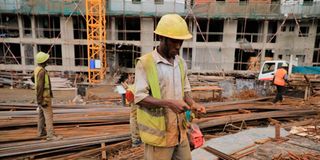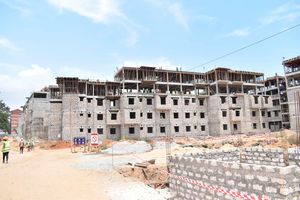How the building sector can tackle climate crisis

In 2022, buildings were responsible for 34 per cent of global energy demand and 37 per cent of energy and process-related carbon dioxide emissions.
What you need to know:
- In 2022, buildings were responsible for 34 per cent of global energy demand and 37 per cent of energy and process-related carbon dioxide (CO2) emissions
The demand for housing and infrastructure is rising in rapidly, urbanising countries like Kenya. This is even as researchers warn that building, construction, and operation emissions could double by 2050 if current trends continue.
In 2022, buildings were responsible for 34 per cent of global energy demand and 37 per cent of energy and process-related carbon dioxide (CO2) emissions. This is according to the Global Status Report for Buildings and Construction.
One of the primary contributors to these emissions is the reliance on energy-intensive materials such as cement and steel. Cement production alone accounts for about eight per cent of global CO2 emissions. Recent analysis suggests that building materials contribute to 55 per cent of industrial carbon emissions, underscoring the necessity for effective mitigation strategies.
The energy demands associated with construction extend beyond the building phase. Ongoing operational energy use for heating, cooling and lighting often relies on fossil fuels unless renewable sources are integrated. And as urban centres expand, energy needs are expected to increase significantly.
Carbon emissions stem from various stages of construction, including the extraction and processing of raw materials, transportation and waste management. This is particularly pronounced in developing countries, where non-renewable energy sources dominate.
But all is not lost.
There is a growing global movement towards sustainable construction practices to combat this challenge. For instance, the European Union aims for a 40 per cent reduction in CO2 emissions from construction materials through circular economy principles. Finland has set an ambitious target of achieving carbon neutrality by 2035 by focusing on refurbishment projects that generate lower emissions than new constructions.
In Kenya, the construction sector has significant opportunities to mitigate its environmental impact by adopting sustainable practices. This includes sourcing materials sustainably and utilising innovative construction methods. Traditional building techniques using earth, stone and timber can substantially reduce carbon footprints.
The Kenya Green Building Society advocates for these practices by promoting a registry of sustainable products and services. The organisation has developed the Jenga Green Library, an initiative to provide a comprehensive resource for developers, buyers, homeowners and urban planners to effectively identify sustainable products and service providers.
Implementing circular economy principles is essential for minimising waste and maximising resource efficiency in construction. This approach involves reusing existing structures, recycling materials, and designing buildings for easy disassembly. The UN Environment Programme advises that repurposing existing buildings can result in 50-75 per cent fewer emissions than new constructions.
A comprehensive life cycle assessment (LCA) approach is crucial for understanding the environmental impacts of construction materials from extraction to disposal. Countries like Germany have successfully integrated LCA into building codes, leading to informed decision-making regarding material selection and construction methods.
Enhancing capacity within the local construction industry is vital for implementing these best practices. Training architects, engineers and builders in sustainable design principles will empower local communities to adopt sustainable practices effectively. Collaboration among stakeholders, governments, academia, and industry professionals can facilitate knowledge sharing tailored to Kenya's and Africa's unique context.
Government support is critical in driving change within the construction sector. Mandatory building codes prioritising sustainability can create a framework for reducing embodied emissions. Countries like Senegal and Ghana are developing roadmaps toward decarbonisation by establishing regulations for sustainable building practices. Kenya could benefit from incentives such as tax breaks or subsidies for projects utilising low-carbon materials or adhering to green building standards.
Innovative construction techniques can also significantly reduce embodied emissions. Utilising lighter structural systems or prefabricated components decreases material requirements while maintaining structural integrity. Research indicates that optimising building shapes can lead to substantial carbon savings. Integrating renewable energy sources like solar power into construction processes can diminish the sector's carbon footprint.
Kenya has a substantial potential for solar energy, with an estimated capacity of 15,000 MW, which companies like Bamburi Cement are tapping into by investing in solar power to enhance sustainability and lower electricity costs. Geothermal resources, particularly in regions like Menengai, provide stable energy sources that can be utilised for high-emission industrial processes.
Transitioning to low-carbon alternatives in material production is crucial for reducing embodied emissions. This includes using green concrete, recycled steel, and bio-based materials such as bamboo and engineered timber. The availability of low-carbon cement options represents progress toward this goal.
Incorporating energy-efficient technologies into material production processes can significantly reduce overall energy demand by optimising manufacturing techniques to minimise waste while enhancing productivity. On-site renewable energy generation through solar panels or wind turbines can power machinery while reducing transportation emissions related to grid electricity.
Building design innovations are essential for mitigating climate change by enhancing energy efficiency and promoting sustainability. Modern designs focus on improved insulation, passive solar techniques, and integrating renewable energy sources like solar panels and wind turbines. Smart technologies allow real-time adjustments to heating, ventilation, and air conditioning systems based on occupancy and environmental conditions, significantly decreasing energy consumption.
Innovative architectural designs are also emerging - zig-zag walls utilise radiative cooling techniques that reflect infrared radiation into the atmosphere rather than absorbing it as heat. This approach helps keep buildings cooler without excessive energy use.
As Kenya continues to navigate its urbanisation challenges, embracing sustainable construction practices will be crucial for reducing carbon emissions and fostering economic growth and resilience against climate impacts. Regulatory frameworks and integration of sustainable building materials will position the country's construction industry as a leader in environmental stewardship while contributing significantly to national development goals.

